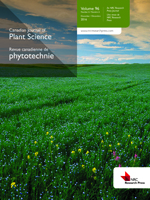Walsh, K. D., Puttick, D. M., Hills M. J., Yang R.-C., Topinka, K. C. and Hall, L. M. 2012. Short Communication: First report of outcrossing rates in camelina [Camelina sativa(L.) Crantz], a potential platform for bioindustrial oils. Can. J. Plant Sci. 92: 681-685. Outcrossing rates in camelina were low (0.09-0.28%), suggesting camelina is a primarily self-pollinated species. Outcrossing was affected by flowering synchrony influenced by planting date as well as direction and distance (20, 40 or 60 cm) from the pollen source. Pollen-mediated intra-specific gene flow is unlikely to prohibit the development of camelina as a bioindustrial platform. Short distance outcrossing results will be used to design experiments to evaluate outcrossing rates at a field scale.
How to translate text using browser tools
1 July 2012
Short Communication: First report of outcrossing rates in camelina [Camelina sativa (L.) Crantz], a potential platform for bioindustrial oils
Kimberly D. Walsh,
Debra M. Puttick,
Melissa J. Hills,
Rong-Cai Yang,
Keith C.,
Linda M. Hall
ACCESS THE FULL ARTICLE
It is not available for individual sale.
This article is only available to subscribers.
It is not available for individual sale.
It is not available for individual sale.

Canadian Journal of Plant Science
Vol. 92 • No. 4
July 2012
Vol. 92 • No. 4
July 2012
adventitious presence
flux génétique attribuable au pollen
outcrossing
pollen-mediated gene flow
Pollinisation croisé e
présence d'adventices




